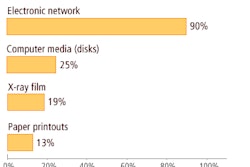PROVIDENCE, RI - Imaging informatics can greatly influence clinical research, but disciplines first must overcome a myriad of technical challenges to get products to market faster and enhance patient care.
Speaking on Saturday at the 2007 annual meeting of the Society for Imaging Informatics in Medicine (SIIM), Dr. Eliot Siegel, vice chairman of the department of diagnostic radiology at the University of Maryland School of Medicine in Baltimore, said that until recently the research community has viewed imaging and related data "as art much more than quantitative science."
"Reliable image data can lead to smaller clinical trials with fewer patients, earlier 'go' or 'no go' decisions on compounds, faster regulatory approval, and shorter time to market," Siegel added. "If we are able to develop quantitative techniques, we can use imaging as the assessment, rather than other parameters" for research.
Siegel is involved in the National Cancer Imaging Archive (NCIA), an image repository of databases, such as the National Cancer Institute (NCI) Lung Imaging Database Consortium (LIDC), as well as the NCI's Cancer Biomedical Informatics GRID (caBIG). The caBIG is a voluntary network that connects some 50 clinical cancer centers around the U.S. to exchange information through a virtual library of databases.
Financial investments
Costs of drug development have risen dramatically over the last 20 years, increasing from approximately $200 million in 1987 to just less than $1 billion in 2003. Because of the escalating expenses, major drug and product submissions to the U.S. Food and Drug Administration (FDA) have decreased over the last decade.
The NCI spends approximately $750 million per year in cancer therapy research, while pharmaceutical companies spend even greater amounts. Despite the large investments in research, only 2% of cancer patients are in clinical trials. One of NCIA's goals is to capture the other 98% and develop a mechanism to quantify their respective responses to therapy and imaging results for all cancer patients.
How well projects such as caBIG perform will depend on whether the medical informatics arena can overcome its obstacles through standardization in several areas. Siegel cited 11 challenges in his presentation at SIIM:
Lack of acquisition standards: "Without an acquisition standard, any measurements are of limiting value. Measurements, such as SUV (standard uptake value) on a PET/CT or even nodule size can vary tremendously, depending how the images are acquired," he said. One possible solution may come from the Uniform Protocols for Imaging in Clinical Trials (UPICT) initiative to create a way to standardize the acquisition.
Lack of a radiology lexicon: Terminology, such as SNOMED, is limited and such studies only can be used in a very small percentage of radiology reports. The development of a radiology lexicon, Siegel said, "is critical," especially without a consensus on an acquisition primer. He used the example of MR sequences with acronyms, such as GRASS (gradient recalled acquisition in the steady state) and ROAST (resonant offset averaging in the steady state). "How those map out from one vendor to another is important to compare one image to another for clinical purposes," he added.
Difficulty measuring lesion size and change over time: "Having a database that will allow us to develop algorithms to facilitate measurements in a semiautomated fashion is critical," Siegel said. "Right now, the state of the art in measuring lesion change and size over time is still at a stage where there is a tremendous amount of work that needs to be done."
Alternatives to Response Evaluation Criteria in Solid Tumors (RECIST): RECIST is the only criteria accepted in the oncology community when it comes to the total sum of all lung dimensions of nodules and tumors in a given patient. A number of researchers are developing more sophisticated ways to measure the size of a lesion on CT. Siegel cited volumetric imaging, dynamic contrast imaging, and functional imaging as potentially viable solutions.
Lack of annotation and markup standards: Markups, such as circles, on one vendor's workstation "almost never can apply to another workstation," Siegel said. "If you have a PACS or research database that has markups done on primary workstations, it is very unlikely you can do any automated search for information."
Data security
Difficulty in acquiring and submitting cases in a secure way: Most PACS are not designed to export images, as most of them are patient-centric. Designing ways to move images over the GRID or through the Internet -- and bypassing firewalls -- is a major area to research.
Multiple image interpretation platforms with different software make comparing and sharing results difficult: Siegel noted studies in which taking the same datasets from five different workstations measuring carotid stenosis, for example, offer five different results from each workstation. The solution is to develop a standard imaging platform that will allow sharing of databases and algorithms.
Lack of standardized datasets: NCIA is developing a number of reference datasets for public download to help alleviate this issue.
The disconnect between the worlds of the GRID and XML: The need is to create a common technological connection between imaging, healthcare, and computer science.
Patient-centric electronic medical records (EMRs) and PACS make data mining difficult: Siegel said it is "pretty much impossible" to launch a PACS that cuts across multiple patients and the EMR system for information access.
The sharing of images and related data: People simply are not used to sharing their data with other investigators after the completion of a study. "The whole idea of being able to take databases and change the culture, so people will be encouraged to share, is essential and our number one challenge," Siegel said.
Solution search
Progress is being made to resolve some of these issues. In particular, caBIG's In Vivo Imaging Workspace has been working to develop software tools to standardize imaging and research. "In a short period of time, the Workspace has come up with some very interesting, complex, and extraordinarily promising projects that have implications in cancer research and imaging in general," Siegel said.
Several organizations, such as the American College of Radiology Imaging Network (ACRIN) and the Quality Assurance Review Center (QARC) at the University of Massachusetts Medical School in Worcester, already use these tools, he noted.
In addition, the NCIA is supporting the eXtensible Imaging Platform (XIP), which is designed to facilitate image collaboration, display, and review in the field research, Siegel said.
By Wayne Forrest
AuntMinnie.com staff writer
June 11, 2007
Related Reading
NCI CAD database program gathers momentum, March 16, 2006
NCI's caBIG imaging group to hold first meeting, December 12, 2005
Copyright © 2007 AuntMinnie.com



















